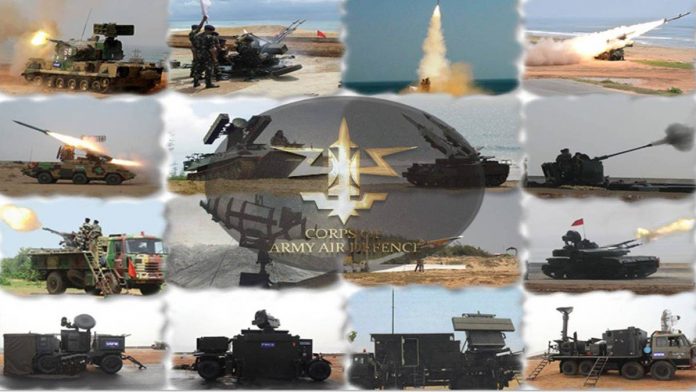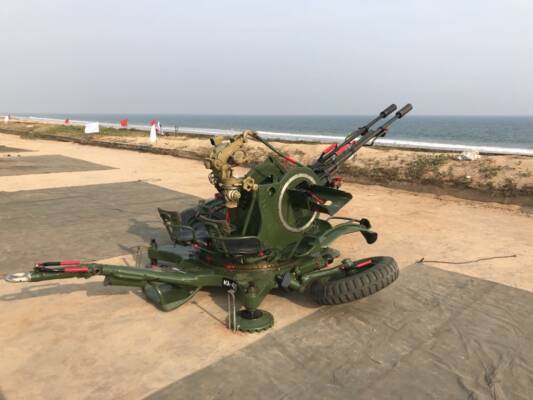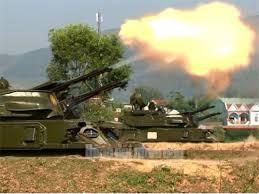
Note from the Editor
As per recent reports, Air Defence Command is to be formed which will encompass the resources of the Indian Air Force, Indian Army and Indian Navy. On the Army Day, let’s have a little insight into the Army Air Defence (AAD) from the pen of a veteran from the same arm.
(“Akashe Shatrun Jahi”)

Introduction
The inclusion of the third dimension in warfare i.e. air led to the need to act against the attacking aircraft and thus a need was felt for “Anti Aircraft Weapons.” In modern warfare, as threat from the air play a decisive role, there will always be a need to protect the vital static assets of the nation as well as retain the freedom in combat zone to manoeuvre mobile combat forces with no or minimum interference from the skies. The maintenance of an effective Air Defence (AD) system both in peace and war is therefore, a national imperative.
Air Defence is a protective reaction against active enemy air threat. There has been an exponential development in the quality and magnitude of air threat due to technological innovations such as stealth, long range precision strike capability and beyond visual range stand-off weapons. Use of smart/ intelligent ammunition makes the air threat more potent and lethal. The Air Defence of the country is a joint responsibility of all the defence forces which includes the Indian Air Force, Army Air Defence and Indian Navy. The Army Air Defence (AAD) is tasked for AD of the Indian Army (IA) as well as national/strategic/earmarked other forces’ assets on land.

Brief History
Air defence artillery in India was first established by the British Government ruling India in 1939, at the start of World War II to counter the growing aerial threat from the Axis powers, especially from the Japanese in East Asia. In July 1940, the government established training schools for anti-aircraft and coastal defence wings at Karachi. In September 1940, an anti-aircraft training battery was formed at Colaba, Mumbai to impart technical training to the troops. The first anti-aircraft unit of Indian Artillery was the Royal High Altitude Airship (‘R’ HAA) Regiment, which was part of the battery based at Colaba. In January 1941, ‘U’ Anti-Aircraft Regiment was raised at Malir Cantonment (now in Pakistan) and in April, both these units were equipped with Bofors 40 mm L/60 guns. The units were renamed as 1 Indian Light Anti-Aircraft Regiment IA and 1 Indian High Altitude Airship Regiment IA respectively.
By 1942, the air defence branch had grown considerably with eighteen operational anti-aircraft regiments, of which nine were High Altitude Airship regiments and nine were Low Altitude Airship regiments. By the end of 1944, this number reached a total of 33 air defence artillery units. However, after actively taking part in the second world war on behalf of the British Empire, many of these were disbanded. After partition, only two units, the 26 and 27 Low Altitude Airship Regiments were retained in India. The two oldest units, I Training Battery and Royal High Altitude Airship (‘R’ HAA) Regiment, were transferred to Pakistan.

In the aftermath of India’s involvement in the Bangladesh Liberation War of 1971, India’s air defence artillery was substantially modernised and various weapons systems were introduced between 1972 and 1978, including the Kvadrat (SAM6) Missile System, ZSU-23-4B “Schilka”, ZU-23-2B guns, 9K33 Osa AK (SAM 14) systems, 9K38 Igla surface-to-air missiles and 9K35 Strela-10 missiles.
During the period of 1987–94, India’s Air Defence Corps recorded several momentous events that refashioned the identity of air defence in India. By the end of 1989, the Air Defence and Guided Missile School and Centre was established at Gopalpur Military Station in Orissa. Subsequently, the air defence wing at the Artillery School was moved to the Air Defence Guided Missile School. In October 1993, the Regiment of Artillery was bifurcated and the Corps of Air Defence Artillery came into existence on January 10, 1994. The new Army Air Defence logo was introduced. The logo of the regiment shows a missile with radar antennae on both sides emitting radar waves.
Present Day
The Army Air Defence today has strength of about 6,000 officers and 85,000 soldiers organised into 55 regiments of all types. The Corps has a variety of regiment equipped with guns in semi static role to guard the static assets, to self propelled guns/ missiles/ gun -missile mix regiments for the combat forces. The regiments are equipped as per the task envisaged with static assets, armoured columns as well as fighting formations in the combat zone. Accordingly, the inventory of the Corps includes a variety of equipment as follows:
• Akash Surface to Air Missile System
• Kub (SA-6 Gainful) Surface to Air Missile System
• S-125 Neva/Pechora Surface to Air Missile System
• S-200 Surface to Air Missile System
• 9K33 Osa (SA-8 Gecko) Surface to Air Missile System
• 9K35 Strela-10 (SA-13 Gopher) Surface to Air Missile System
• 9K22 Tunguska Gun-Missile System
• ZSU-23-4M ‘Shilka’ Self Propelled Gun System
• ZSU-23-2 Guns
• FIM-92 Stinger and Igla 1M Manportable Surface to Air Shoulder Fired Missiles
In order to effectively support the weapon systems, the regiments are suitably equipped with a variety of radar systems for low level surveillance (up to 5,000 feet), scan the air space and track the enemy targets. The Air Defence Control & Reporting System is developed to transfer the target data in near real time to the tactically suitable weapon system for effective engagement of the selected target(s).

Air Defence Command
Presently, a Joint Air Defence Centre has been set up during operations with resources from the Indian Air Force and Army for optimal utilisation of Air Defence resources and effective conduct of the Air Defence battle. This was to ensure that the air space management is carried out effectively for safety of own aircraft and aerial vehicles operating in the combat zone and effective engagement of enemy aerial intruders. In order to duly support the same, the surveillance radar network of the Indian Air Force and Army is integrated with seamless exchange of information.
However, with increasing complexity in the modern warfare techniques where reduced reaction time is available and number of aerial space users have substantially increased, there is a need for speed in decision making in real time, for which, it is imperative to seamlessly integrate the air Defence operations of all three services over the entire air space of the nation. This is therefore became an underlying need to form an Air Defence Command, where the entire air space of the country is protected under a unified agency while keeping autonomy of each service to cater the needs of their specific operations. The establishment of the Air Defence Command will enable the resources of the three services for the Air Defence battle to be optimally utilized depending on the tactical scenario, availability and location of the resources.
Conclusion
Army Air Defence is Sentinels of the Sky providing protection to the combat as well as the non combat assets of the IA as well as the nation against threat from air. They have proved their mettle over the years and live to justify their motto. In modern wars, they will be the foreunners to bear and thwart the first attacks from the enemy.
Jai Hind
–The author is an Indian Army veteran, and has been Principal Consultant to Department of Urban Development, Govt of MP for Smart City Projects. He can be reached at: manoj_42ch@yahoo.co.in. The views expressed are personal and do not necessarily reflect the views of Raksha Anirveda.








